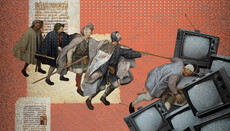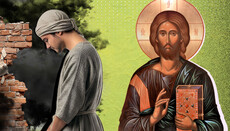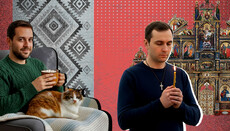Why the Church will never have an alternative to Halloween

The Church is open to everyone, but only in the sense that “everyone” means those who have believed in Christ, taken up their cross, and followed Him. For everyone else, the Church is a closed community.
The Halloween celebrations have passed – on a mass scale and nearly everywhere. Orthodox commentators have asked: what could serve as an alternative?
Take, for example, the rather well-known Telegram channel “Cheerful Archdeacon Andrei Palchuk.” Father Andrei walked around Odessa, talking with young people dressed in devilish costumes, asking them about their motivations. In the end, he said that this culture, foreign to Christianity, would take hold of our youth’s minds and shape our future, and something must be done about it. He also said that young people need some kind of alternative and asked viewers to write their suggestions in the comments.
Father Andrei’s interlocutors on the streets of Odessa mostly said that Halloween and all the devilish masquerade related to it allow young people to express themselves, socialize with friends, and engagingly have fun. Most of the comments on the Telegram channel boiled down to the idea that, in order to “win over” the youth, the Church should also organize various events, give young people opportunities for self-expression, and engage them in interesting activities.
The reasoning is logical, but let us reflect on the following.
More than thirty years ago, the Church in our country gained freedom of action, began rebuilding churches and monasteries, opening Sunday schools, engaging in missionary work, and trying to reach as many people as possible with Christian preaching. In other words, providing precisely those Christian alternatives. And what did we get? Our youth are overwhelmingly dressing up in demonic costumes and joyfully celebrating Halloween. Despite many years of work by all our synodal and eparchial departments for education, missionary activity, and youth outreach, we have to acknowledge a bitter truth: we have completely lost the battle for people’s minds.
Maybe, we simply don’t know how to work with young people? But in Western countries, where Catholics, and even more so Protestants, work with youth very effectively, there are still even more Halloween celebrants. Christian communities there offer plenty of vivid and engaging alternatives. Yet, Halloween still wins.
Another example: Brazil is considered one of the most Christianized countries in the world. Yet in 2011, around 4.1 million people participated in the Pride march in São Paulo. So, who is really winning the battle for people’s souls?
Perhaps efforts need to be made at the state level? Let’s look at what existed before the 1917 revolution.
The Church was a state institution – everyone was required to confess, take communion, and submit proof of it to government authorities. Crowds attended processions, and churches were full. But if you read the works by ethnographers from the late 19th to early 20th century (Afanasev, Dal, Kostomarov, Sakharov, Potebnya, and others), a very different picture emerges.
In almost every village, there was a sorcerer, a seer, a whisperer, or an old woman who could cast curses or protect against them, and so on. And the majority of the people, who regularly attended churches, also engaged in love charms, counter-charms, spells, and other pagan and occult practices. Essentially, it was the same as Halloween.
Protestants long ago proclaimed the slogan: the Church must be open to everyone. At the Second Vatican Council in 1965, Catholics adopted the principle of aggiornamento, that is, “renewal” or “alignment with contemporary requirements”. Similar calls often come from many Orthodox hierarchs. In fact, today’s appeals to offer people alternatives, to engage them, to provide opportunities for self-expression are very much in the same vein.
All of this is logical and correct but from our human perspective. If we turn to the Gospel, however, we see that it all misses the point.
The Church is expected to be open and to meet people’s expectations. These expectations can be roughly formulated as follows: give us something more interesting (or better, “cooler”) than Halloween, and we will come to the Church. But should the Church simply follow these demands? Let us listen to what the Apostle Paul said: “Jews demand signs and Greeks look for wisdom, but we preach Christ crucified: a stumbling block to Jews and foolishness to Gentiles…” (1 Cor. 1:22–23).
People expect from us opportunities for self-realization, excitement, and so on. But shouldn’t we instead preach Christ crucified?
Some might say: no one would listen to such preaching today. But did the Apostle Paul have a different audience? Didn’t people two thousand years ago, just like now, want to be healthy, happy, and enjoy life? As it is said in the Gospel: “And he said to all, ‘If anyone would come after me, let him deny himself and take up his cross daily and follow me’” (Luke 9:23).
Let us pay attention: the evangelist Luke points out to whom these words were addressed: “to all”. Not to the perfect, not to those especially advanced in spiritual life, but to all. Can the Church of Christ preach anything else?
A historical fact: in terms of numbers, the preaching of the apostles and their successors was not very successful. Most people did not listen to it at all, and of those who did, the majority were not inspired by it.
For example, the people of Athens simply mocked the Apostle Paul: “When they heard about the resurrection of the dead, some ridiculed him, while others said, ‘We’ll hear you about this some other time’” (Acts 17:32). Only a few, however, joined him and believed (Acts 17:34). By the early third century, according to historians such as Rodney Stark, Ramsay MacMullen, and Keith Hopkins, Christians made up no more than 1–2% of the population of the Roman Empire. The spread of Christianity was a slow and gradual process.
Bringing as many people as possible into the Church was never the goal of Christian preaching. Christ did not send the apostles for that. “Go into all the world and preach the gospel to all creation. Whoever believes and is baptized will be saved; whoever does not believe will be condemned” (Mark 16:15–16). Another quote: “Go therefore and make disciples of all nations, baptizing them in the name of the Father and of the Son and of the Holy Spirit, teaching them to observe all that I have commanded you. And behold, I am with you always, to the end of the age” (Matthew 28:19–20). And what did Christ teach? “Deny yourself, take up your cross,” and so on.
The entire Sermon on the Mount is unacceptable to a person who is focused on worldly well-being, comfort, self-fulfillment, and the like. Yet the Church of Christ can offer nothing else to humanity.
A striking example of this is found in chapter 6 of the Gospel of John, where Christ speaks about the Communion of His Body and Blood: “Jesus said to them, ‘Truly, truly, I say to you, unless you eat the flesh of the Son of Man and drink His blood, you have no life in you’” (John 6:53). Today, we understand that this does not mean cannibalism, but at the time, His listeners took it literally – and to them, it must have seemed utterly absurd.
“On hearing it, many of his disciples said, ‘This is a hard teaching. Who can accept it?’” (John 6:60). But the Lord does not attempt to resolve their confusion, does not reassure them, and offers no further explanation. When “From this time many of His disciples turned back and no longer followed Him” (John 6:66). He does not try to bring them back. Moreover, He does not even try to hold onto the twelve apostles, but asks them, “Do you also want to go away?” (John 6:67). Where is the desire to attract attention? Where is the opportunity for self-expression? Where is the struggle to win people’s minds? Where is a Church open to everyone?
The Church is open to all, but only in the sense that “all” refers to those who have believed in Christ, taken up their cross, and followed Him. For everyone else, the Church is a closed society.
This is precisely how the Church understood itself in the early centuries. From that understanding, we still retain the liturgical exclamation: “Doors! Doors!”, which, in essence, was a command to close the doors of the church gathering so that no outsiders could enter this closed community during the celebration of the Eucharist. Only the faithful, only those who follow Christ. And to enter this closed community, the ekklesia, considerable effort was required: first, repentance and turning away from sin, and then instruction in Christian teaching.
All of this sounds very strict and may even seem unacceptable to modern church sensibilities. But the Church’s primary responsibility is to bring people the teaching of Christ, no matter how rigorous it is, and no matter how few respond to it. This is the only alternative the Church can offer. Attempts to offer people anything else will not succeed. Halloween and gay pride parades are all conclusive proof of that.











